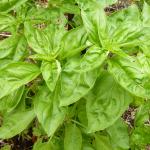Growing Basil
Ocimum basilicum : Lamiaceae / the mint family
| Jan | Feb | Mar | Apr | May | Jun | Jul | Aug | Sep | Oct | Nov | Dec |
|---|---|---|---|---|---|---|---|---|---|---|---|
| S | |||||||||||
| T | |||||||||||
| P | P |
(Best months for growing Basil in USA - Zone 5a regions)
- S = Plant undercover in seed trays
- T = Plant out (transplant) seedlings
- P = Sow seed
- Grow in seed trays, and plant out in 4-6 weeks. Sow seed at a depth approximately three times the diameter of the seed. Best planted at soil temperatures between 64°F and 95°F.
- Space plants: 8 - 10 inches apart
- Harvest in 10-12 weeks. Pick before flowering.
- Compatible with (can grow beside): Tomato
A frost tender low-growing herb. Basil is a culinary herb prominently featured in Italian cuisine, and also plays a major role in the Southeast Asian cuisines of Thailand, Vietnam, Cambodia, and Laos. The plant tastes somewhat like anise, with a strong, pungent sweet smell. There are many varieties including Thai, purple ruffles, and lemon.
In frost-free regions perennial basil varieties will survive for years and the bush will keep on getting bigger and bigger.
Can be grown inside in pots in winter. As the plant develops, pinch out the top to encourage bushy growth. Pick off the flowers to encourage more leaf growth.
Culinary hints - cooking and eating Basil
Basil is commonly used fresh in cooked recipes. It is generally added at the last moment, as cooking quickly destroys the flavour. Tear rather than chop.
The fresh herb can be kept for a short time in plastic bags in the refrigerator, or for a longer period in the freezer, after being blanched quickly in boiling water.



Your comments and tips